The Influence of Urbanization and Environmental Factors on the Financial Performance of Retail and Automotive Industries in China
Abstract
:1. Introduction
1.1. Literature Review
1.2. Research Questions
- How do urbanization and environmental factors affect the financial performance of the retail and automotive industries in China?
- Are there sector-specific effects of environmental factors and urbanization on these industries?
- How do the effects of environmental factors and urbanization on corporate financial performance evolve over time?
- What are the implications of the study’s findings for policymakers and industry stakeholders?
2. Data and Methodology
2.1. Theoretical Framework
2.1.1. Urbanization and Corporate Financial Performance
2.1.2. PM2.5 Air Pollution and Corporate Financial Performance
2.2. Model Construction
2.3. Data Collection
3. Results
3.1. Preliminary Statistics
3.1.1. Descriptive Statistics
3.1.2. Correlation Matrix
3.2. Urbanization and Corporate Financial Performance
3.2.1. Influence of Urban Population Growth on Total Retail Sales of Consumer Goods
3.2.2. Influence of Urban Population Growth on the Online Retail Sales of Consumer Goods
3.2.3. Influence of Urban Population Growth on the Sales of Passenger Cars
3.2.4. Influence of Urban Infrastructure on Total Retail Sales of Consumer Goods
3.2.5. Influence of Urban Infrastructure on Online Retail Sales
3.2.6. Influence of Urban Infrastructure on the Sale of Passenger Cars
3.3. Environment and Corporate Financial Performance
3.3.1. Influence of PM2.5 Pollution on the Total Retail Sales of Consumer Goods
3.3.2. Influence of PM2.5 Pollution on Online Retail Sales
3.3.3. Influence of PM2.5 Pollution on the Sale of Passenger Cars
3.4. Urban Population Moderation in the Environment and Corporate Financial Performance Nexus
3.4.1. Urban Population Moderation in the Influence of PM2.5 on the Total Retail Sales of Consumer Goods
3.4.2. Urban Population Moderation in the Influence of PM2.5 on Online Retail Sales
3.4.3. Urban Population Moderation in the Influence of PM2.5 on the Sales of Passenger Cars
4. Discussion
4.1. Temporal Dynamics: Unraveling Changing Trends
4.2. Transitions in Infrastructure and Consumer Behavior
4.3. Environmental Concerns across Eras
4.4. Urban Population Moderation over Time
4.5. Navigating Changing Tides: Implications for the Future
5. Conclusions
Author Contributions
Funding
Institutional Review Board Statement
Informed Consent Statement
Data Availability Statement
Acknowledgments
Conflicts of Interest
References
- Blankespoor, B.; Khan, A.; Selod, H. Consolidating Data of Global Urban Populations: A Comparative Approach. AGUFM 2017, 2017, IN52B-03. Available online: https://ui.adsabs.harvard.edu/abs/2017AGUFMIN52B..03B/abstract (accessed on 13 June 2023).
- Cohen, A.J.; Brauer, M.; Burnett, R.; Anderson, H.R.; Frostad, J.; Estep, K.; Balakrishnan, K.; Brunekreef, B.; Dandona, L.; Dandona, R.; et al. Estimates and 25-year trends of the global burden of disease attributable to ambient air pollution: An analysis of data from the Global Burden of Diseases Study 2015. Lancet 2017, 389, 1907–1918. [Google Scholar] [CrossRef]
- Zhou, Q.; Nizamani, M.M.; Zhang, H.-Y. The air we breathe: An In-depth analysis of PM2.5 pollution in 1312 cities from 2000 to 2020. Environ. Sci. Pollut. Res. 2023, 30, 93900–93915. [Google Scholar] [CrossRef]
- Shah, J.; Mishra, B. Analytical equations based prediction approach for PM2.5 using artificial neural network. SN Appl. Sci. 2020, 2, 1–15. [Google Scholar] [CrossRef]
- Wang, C.; Yang, Y.; Zhang, J. China’s sectoral strategies in energy conservation and carbon mitigation. Clim. Policy 2015, 15, S60–S80. [Google Scholar] [CrossRef]
- Ennouri, K.; Smaoui, S.; Triki, M.A. Detection of Urban and Environmental Changes via Remote Sensing. Circ. Econ. Sustain. 2021, 1, 1423–1437. [Google Scholar] [CrossRef] [PubMed]
- Yang, L.; Ma, N. Empirical Study on the Influence of Urban Environmental Industrial Structure Optimization on Ecological Landscape Greening Construction. Int. J. Environ. Res. Public Health 2022, 19, 16842. [Google Scholar] [CrossRef] [PubMed]
- Hashmi, S.H.; Fan, H.; Fareed, Z.; Shahzad, F. Asymmetric nexus between urban agglomerations and environmental pollution in top ten urban agglomerated countries using quantile methods. Environ. Sci. Pollut. Res. 2020, 28, 13404–13424. [Google Scholar] [CrossRef]
- Kuddus, A.; Tynan, E.; McBryde, E. Urbanization: A problem for the rich and the poor? Public Health Rev. 2020, 41, 1–4. [Google Scholar] [CrossRef]
- Horváthová, E. Does environmental performance affect financial performance? A meta-analysis. Ecol. Econ. 2010, 70, 52–59. [Google Scholar] [CrossRef]
- Pham, D.C.; Do, T.N.A.; Doan, T.N.; Nguyen, T.X.H.; Pham, T.K.Y. The impact of sustainability practices on financial performance: Empirical evidence from Sweden. Cogent Bus. Manag. 2021, 8, 1912526. [Google Scholar] [CrossRef]
- Nguyen, L.-T. The relationship between environmental performance and financial performance: Evidence from an emerging East Asian economy. Int. J. Discl. Gov. 2022, 20, 1–14. [Google Scholar] [CrossRef]
- Seto, K.C.; Güneralp, B.; Hutyra, L.R. Global forecasts of urban expansion to 2030 and direct impacts on biodiversity and carbon pools. Proc. Natl. Acad. Sci. USA 2012, 109, 16083–16088. [Google Scholar] [CrossRef] [PubMed]
- Zhang, T.; Song, Y.; Yang, J. Relationships between urbanization and CO2 emissions in China: An empirical analysis of population migration. PLoS ONE 2021, 16, e0256335. [Google Scholar] [CrossRef]
- Zhang, N.; Yu, K.; Chen, Z. How does urbanization affect carbon dioxide emissions? A cross-country panel data analysis. Energy Policy 2017, 107, 678–687. [Google Scholar] [CrossRef]
- Liang, W.; Yang, M. Urbanization, economic growth and environmental pollution: Evidence from China. Sustain. Comput. Inform. Syst. 2019, 21, 1–9. [Google Scholar] [CrossRef]
- Wang, Q.; Wu, S.-D.; Zeng, Y.-E.; Wu, B.-W. Exploring the relationship between urbanization, energy consumption, and CO2 emissions in different provinces of China. Renew. Sustain. Energy Rev. 2016, 54, 1563–1579. [Google Scholar] [CrossRef]
- Glaeser, E.L.; Nathanson, C.G. An extrapolative model of house price dynamics. J. Financ. Econ. 2017, 126, 147–170. [Google Scholar] [CrossRef]
- Wang, S.; Li, G.; Fang, C. Urbanization, economic growth, energy consumption, and CO2 emissions: Empirical evidence from countries with different income levels. Renew. Sustain. Energy Rev. 2018, 81, 2144–2159. [Google Scholar] [CrossRef]
- Chen, H.; Tackie, E.A.; Ahakwa, I.; Musah, M.; Salakpi, A.; Alfred, M.; Atingabili, S. Does energy consumption, economic growth, urbanization, and population growth influence carbon emissions in the BRICS? Evidence from panel models robust to cross-sectional dependence and slope heterogeneity. Environ. Sci. Pollut. Res. 2022, 29, 37598–37616. [Google Scholar] [CrossRef]
- Lankoski, L. Corporate responsibility activities and economic performance: A theory of why and how they are connected. Bus. Strat. Environ. 2008, 17, 536–547. [Google Scholar] [CrossRef]
- Ruan, L.; Liu, H. Environmental, Social, Governance Activities and Firm Performance: Evidence from China. Sustainability 2021, 13, 767. [Google Scholar] [CrossRef]
- Bag, D.; Mohanty, S. Impact of Environmental, Social and Governance (ESG) Factors on Stock Returns of Emerging Markets. SSRN Electron. J. 2021. [Google Scholar] [CrossRef]
- Trevlopoulos, N.S.; Tsalis, T.A.; Evangelinos, K.I.; Tsagarakis, K.P.; Vatalis, K.I.; Nikolaou, I.E. The influence of envi-ronmental regulations on business innovation, intellectual capital, environmental and economic performance. Environ. Syst. Decis. 2021, 41, 163–178. [Google Scholar] [CrossRef]
- Zhu, Q.; Sarkis, J.; Lai, K.-H. Green supply chain management innovation diffusion and its relationship to organizational improvement: An ecological modernization perspective. J. Eng. Technol. Manag. 2012, 29, 168–185. [Google Scholar] [CrossRef]
- Busch, T.; Lewandowski, S. Corporate Carbon and Financial Performance: A Meta-analysis. J. Ind. Ecol. 2018, 22, 745–759. [Google Scholar] [CrossRef]
- Gleißner, W.; Günther, T.; Walkshäusl, C. Financial sustainability: Measurement and empirical evidence. J. Bus. Econ. 2022, 92, 467–516. [Google Scholar] [CrossRef]
- Chen, Y.; Tan, X.; Cao, S. Financial Development and Energy Environmental Performance: Evidence from China’s Re-gional Economies. Environ. Sci. Pollut. Res. 2023, 30, 76528–76542. [Google Scholar] [CrossRef] [PubMed]
- Glaeser, E.L.; Kolko, J.; Saiz, A. Consumer city. J. Econ. Geogr. 2001, 1, 27–50. [Google Scholar] [CrossRef]
- Zhang, K.; Batterman, S. Air pollution and health risks due to vehicle traffic. Sci. Total. Environ. 2013, 450–451, 307–316. [Google Scholar] [CrossRef]
- Lanoie, P.; Patry, M.; Lajeunesse, R. Environmental regulation and productivity: Testing the porter hypothesis. J. Product. Anal. 2008, 30, 121–128. [Google Scholar] [CrossRef]
- Hamed, R.; Al-Shattarat, W.; Mahmood, F.; Al-Shattarat, B.; Hassanein, A. Does corporate sustainable development still promote corporate financial performance during global crises? Empirical Study from China. Cogent Bus. Manag. 2023, 10, 2190195. [Google Scholar] [CrossRef]
- Pope, C.A.; Burnett, R.T.; Thun, M.J.; Calle, E.E.; Krewski, D.; Ito, K.; Thurston, G.D. Lung Cancer, Cardiopulmonary Mortality, and Long-Term Exposure to Fine Particulate Air Pollution. JAMA Net. 2002, 287, 1132–1141. [Google Scholar] [CrossRef] [PubMed]
- Manisalidis, I.; Stavropoulou, E.; Stavropoulos, A.; Bezirtzoglou, E. Environmental and Health Impacts of Air Pollution: A Review. Front. Public Health 2020, 8, 505570. [Google Scholar] [CrossRef] [PubMed]
- Sharma, S.; Chandra, M.; Kota, S.H. Health Effects Associated with PM2.5: A Systematic Review. Curr. Pollut. Rep. 2020, 6, 345–367. [Google Scholar] [CrossRef]
- Gurjar, B.; Jain, A.; Sharma, A.; Agarwal, A.; Gupta, P.; Nagpure, A.; Lelieveld, J. Human health risks in megacities due to air pollution. Atmos. Environ. 2010, 44, 4606–4613. [Google Scholar] [CrossRef]
- Brook, R.D.; Rajagopalan, S.; Arden PopeIII, C.; Brook, J.R.; Bhatnagar, A.; Diez-Roux, A.V.; Holguin, F.; Hong, Y.; Luepker, R.V.; Mittleman, M.A.; et al. Particulate matter air pollution and cardiovascular disease: An update to the scientific statement from the American Heart Association. Circulation 2010, 121, 2331–2378. [Google Scholar] [CrossRef] [PubMed]
- Sun, X.; Zhao, T.; Liu, D.; Gong, S.; Xu, J.; Ma, X. Quantifying the Influences of PM2.5 and Relative Humidity on Change of Atmospheric Visibility over Recent Winters in an Urban Area of East China. Atmosphere 2020, 11, 461. [Google Scholar] [CrossRef]
- Pala, K.; Aykac, N.; Yasin, Y. Premature deaths attributable to long-term exposure to PM2.5 in Turkey. Environ. Sci. Pollut. Res. 2021, 28, 51940–51947. [Google Scholar] [CrossRef] [PubMed]
- Kan, H.; London, S.J.; Chen, G.; Zhang, Y.; Song, G.; Zhao, N.; Jiang, L.; Chen, B. Differentiating the effects of fine and coarse particles on daily mortality in Shanghai, China. Environ. Int. 2007, 33, 376–384. [Google Scholar] [CrossRef]
- Huang, R.-J.; Zhang, Y.; Bozzetti, C.; Ho, K.-F.; Cao, J.-J.; Han, Y.; Daellenbach, K.R.; Slowik, J.G.; Platt, S.M.; Canonaco, F.; et al. High secondary aerosol contribution to particulate pollution during haze events in China. Nature 2014, 514, 218–222. [Google Scholar] [CrossRef]
- Liu, Y.; Zang, Y.; Yang, Y. China’s rural revitalization and development: Theory, technology and management. J. Geogr. Sci. 2020, 30, 1923–1942. [Google Scholar] [CrossRef]
- Zhang, S.; Zhao, J.; Jiang, Y.; Cheshmehzangi, A.; Zhou, W. Assessing the Rural–Urban Transition of China during 1980–2020 from a Coordination Perspective. Land 2023, 12, 1175. [Google Scholar] [CrossRef]
- Cheng, M.; Duan, C. The changing trends of internal migration and urbanization in China: New evidence from the seventh National Population Census. China Popul. Dev. Stud. 2021, 5, 275–295. [Google Scholar] [CrossRef]
- Glaeser, E.L.; Resseger, M.G. The complementarity between cities and skills. J. Reg. Sci. 2010, 50, 221–244. [Google Scholar] [CrossRef]
- Khan, K.I.; Mata, M.N.; Martins, J.M.; Nasir, A.; Dantas, R.M.; Correia, A.B.; Saghir, M.U. Impediments of Green Finance Adoption System: Linking Economy and Environment. Emerg. Sci. J. 2022, 6, 217–237. [Google Scholar] [CrossRef]
- Duranton, G.; Puga, D. Micro-Foundations of Urban Agglomeration Economies. In Handbook of Regional and Urban Economics; Elsevier: Amsterdam, The Netherlands, 2004; Volume 4, pp. 2063–2117. [Google Scholar] [CrossRef]
- Knoben, J. Localized inter-organizational linkages, agglomeration effects, and the innovative performance of firms. Ann. Reg. Sci. 2009, 43, 757–779. [Google Scholar] [CrossRef]
- Melitz, M.J.; Redding, S.J. Heterogeneous Firms and Trade. In Handbook of International Economics; Elsevier: Amsterdam, The Netherlands, 2014; Volume 4, pp. 1–54. [Google Scholar] [CrossRef]
- Donaldson, D. Railroads of the Raj: Estimating the Impact of Transportation Infrastructure. Am. Econ. Rev. 2018, 108, 899–934. [Google Scholar] [CrossRef]
- Glaeser, E.L.; Kohlhase, J.E. Cities; Regions, and the Decline of Transport Costs; Springer: Berlin/Heidelberg, Germany, 2004. [Google Scholar] [CrossRef]
- Tang, D.Y.; Zhang, Y. Do shareholders benefit from green bonds? J. Corp. Financ. 2018, 61, 101427. [Google Scholar] [CrossRef]
- Hang, N.P.T. Policy Implications for the Green Bank Development in the Context of Global Climate Change. Emerg. Sci. J. 2022, 6, 817–833. [Google Scholar] [CrossRef]
- Guo, Y.; Li, S.; Tian, Z.; Pan, X.; Zhang, J.; Williams, G. The burden of air pollution on years of life lost in Beijing, China, 2004–2008: Retrospective regression analysis of daily deaths. BMJ 2013, 347, f7139. [Google Scholar] [CrossRef] [PubMed]
- Li, W.J.; Chen, S.R.; Xu, Y.S.; Guo, X.C.; Sun, Y.L.; Yang, X.Y.; Wang, Z.F.; Zhao, X.D.; Chen, J.M.; Wang, W.X. Mixing state and sources of submicron regional background aerosols in the northern Qinghai–Tibet Plateau and the influence of biomass burning. Atmos. Chem. Phys. 2015, 15, 13365–13376. [Google Scholar] [CrossRef]
- Flammer, C. Corporate Social Responsibility and Shareholder Reaction: The Environmental Awareness of Investors. Acad. Manag. J. 2013, 56, 758–781. [Google Scholar] [CrossRef]
- Zhang, X.; Zhang, X.; Chen, X. Happiness in the air: How does a dirty sky affect mental health and subjective well-being? J. Environ. Econ. Manag. 2017, 85, 81–94. [Google Scholar] [CrossRef]
- Li, H.; Zhou, L.-A. Political turnover and economic performance: The incentive role of personnel control in China. J. Public Econ. 2005, 89, 1743–1762. [Google Scholar] [CrossRef]
- Cao, S.; Nie, L.; Sun, H.; Sun, W.; Taghizadeh-Hesary, F. Digital finance, green technological innovation and energy-environmental performance: Evidence from China’s regional economies. J. Clean. Prod. 2021, 327, 129458. [Google Scholar] [CrossRef]
- Suoniemi, S.; Meyer-Waarden, L.; Munzel, A.; Zablah, A.R.; Straub, D. Big data and firm performance: The roles of market-directed capabilities and business strategy. Inf. Manag. 2020, 57, 103365. [Google Scholar] [CrossRef]
- Batten, D.F. Network Cities: Creative Urban Agglomerations for the 21st Century. Urban Stud. 1995, 32, 313–327. [Google Scholar] [CrossRef]
- Monsuwé, T.P.Y.; Dellaert, B.G.; de Ruyter, K. What drives consumers to shop online? A literature review. Int. J. Serv. Ind. Manag. 2004, 15, 102–121. [Google Scholar] [CrossRef]
- Tsai, Y.-H. Quantifying Urban Form: Compactness versus “Sprawl”. Urban Stud. 2005, 42, 141–161. [Google Scholar] [CrossRef]
- Banister, D. The sustainable mobility paradigm. Transp. Policy 2008, 15, 73–80. [Google Scholar] [CrossRef]
- Zhang, J.; Mu, Q. Air pollution and defensive expenditures: Evidence from particulate-filtering facemasks. J. Environ. Econ. Manag. 2017, 92, 517–536. [Google Scholar] [CrossRef]
- Wang, P.; Liu, Q.; Qi, Y. Factors influencing sustainable consumption behaviors: A survey of the rural residents in China. J. Clean. Prod. 2014, 63, 152–165. [Google Scholar] [CrossRef]
- Liu, L.; Fang, J.; Li, M.; Hossin, A.; Shao, Y. The effect of air pollution on consumer decision making: A review. Clean. Eng. Technol. 2022, 9, 100514. [Google Scholar] [CrossRef]
- Kraus, S.; Jones, P.; Kailer, N.; Weinmann, A.; Chaparro-Banegas, N.; Roig-Tierno, N. Digital Transformation: An Overview of the Current State of the Art of Research. SAGE Open 2021, 11. [Google Scholar] [CrossRef]
- Bayham, J.; Burkhardt, J.; Coffman, M.; Hayashida, S.; La Croix, S. Does air pollution increase electric vehicle adoption? Evidence from U.S. metropolitan areas, 2011–2018. J. Environ. Econ. Policy 2022, 11, 438–462. [Google Scholar] [CrossRef]
- Zhou, L.; Dai, L.; Zhang, D. Online Shopping Acceptance Model-A Critical Survey of Consumer Factors in Online Shopping. jecr.org. Available online: http://www.jecr.org/sites/default/files/08_1_p04.pdf (accessed on 1 July 2023).
- Tao, F.; Cheng, Y.; Zhang, L.; Nee, A.Y.C. Advanced manufacturing systems: Socialization characteristics and trends. J. Intell. Manuf. 2015, 28, 1079–1094. [Google Scholar] [CrossRef]
- Ostermeijer, F.; Koster, H.R.A.; van Ommeren, J.; Nielsen, V.M. Automobiles and urban density. J. Econ. Geogr. 2022, 22, 1073–1095. [Google Scholar] [CrossRef]
- Alam, K.; Imran, S. The digital divide and social inclusion among refugee migrants: A case in regional Australia. Inf. Technol. People 2015, 28, 344–365. [Google Scholar] [CrossRef]
- Wang, H.; Huang, Z.; Liang, Y.; Zhang, Q.; Hu, S.; Cui, L.; An, X. Dynamic evolution of urban infrastructure resilience and its spatial spillover effects: An empirical study from China. PLoS ONE 2023, 18, e0282194. [Google Scholar] [CrossRef]
- Hortaçsu, A.; Syverson, C. The Ongoing Evolution of US Retail: A Format Tug-of-War. J. Econ. Perspect. 2015, 29, 89–112. [Google Scholar] [CrossRef]
- Bento, A.M.; Cropper, M.L.; Mobarak, A.M.; Vinha, K. The Effects of Urban Spatial Structure on Travel Demand in the United States. Rev. Econ. Stat. 2005, 87, 466–478. [Google Scholar] [CrossRef]
- Long, F.; Zheng, L.; Song, Z. High-speed rail and urban expansion: An empirical study using a time series of nighttime light satellite data in China. J. Transp. Geogr. 2018, 72, 106–118. [Google Scholar] [CrossRef]
- Hao, H.; Wang, H.; Ouyang, M. Comparison of policies on vehicle ownership and use between Beijing and Shanghai and their impacts on fuel consumption by passenger vehicles. Energy Policy 2011, 39, 1016–1021. [Google Scholar] [CrossRef]
- Nora, H.; Allison, H.; Richard, W. The Environment in Anthropology (Second Edition); NYU Press: New York, NY, USA, 2020; ISBN 9781479862689. [Google Scholar]
- Zheng, S.; Wang, J.; Sun, C.; Zhang, X.; Kahn, M.E. Air pollution lowers Chinese urbanites’ expressed happiness on social media. Nat. Hum. Behav. 2019, 3, 237–243. [Google Scholar] [CrossRef]
- Qiu, Q.; Wang, Y.; Qiao, S.; Liu, R.; Bian, Z.; Yao, T.; Nguyen, T.S. Does air pollution affect consumer online purchasing behavior? The effect of environmental psychology and evidence from China. J. Clean. Prod. 2020, 260, 120795. [Google Scholar] [CrossRef]
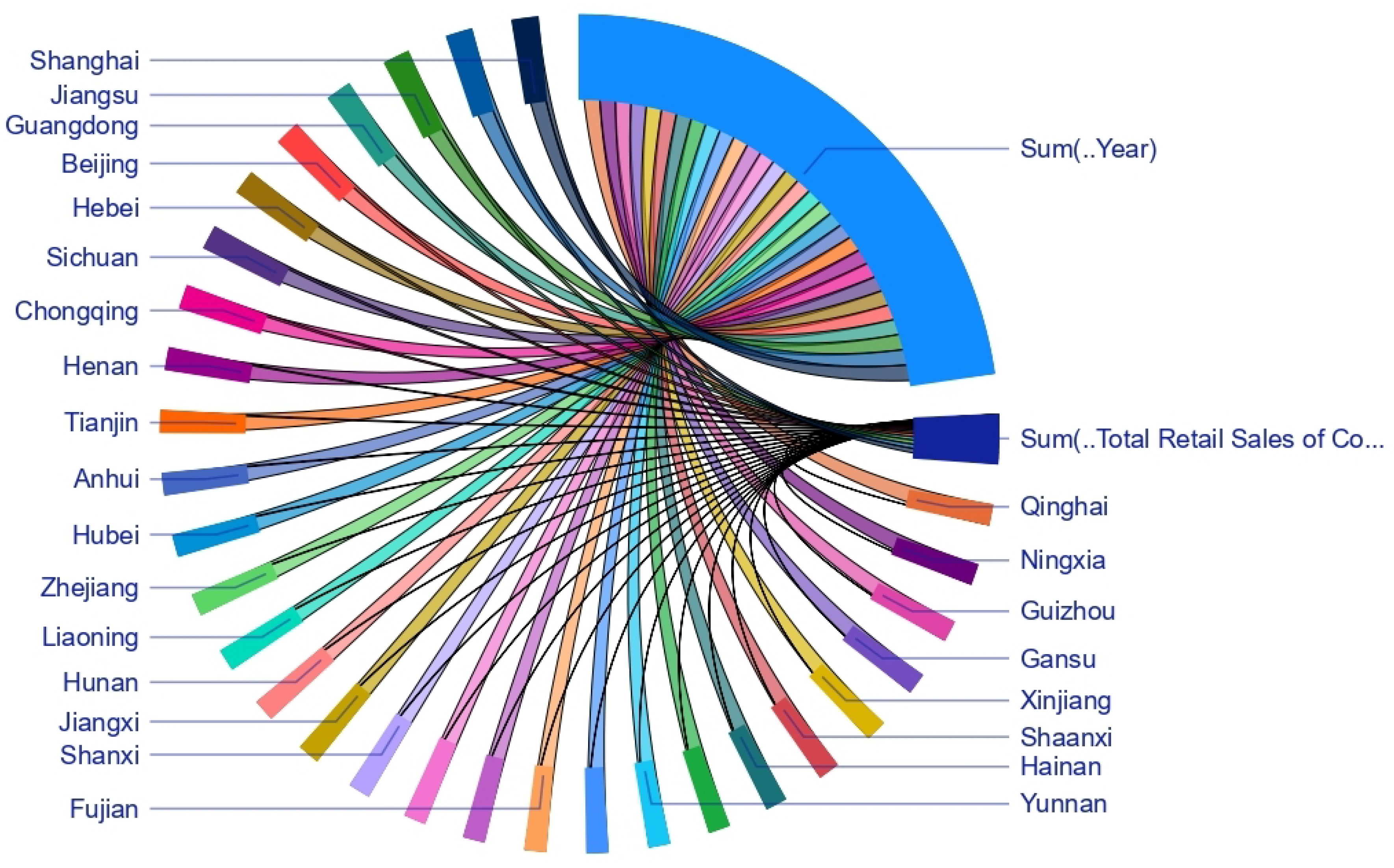
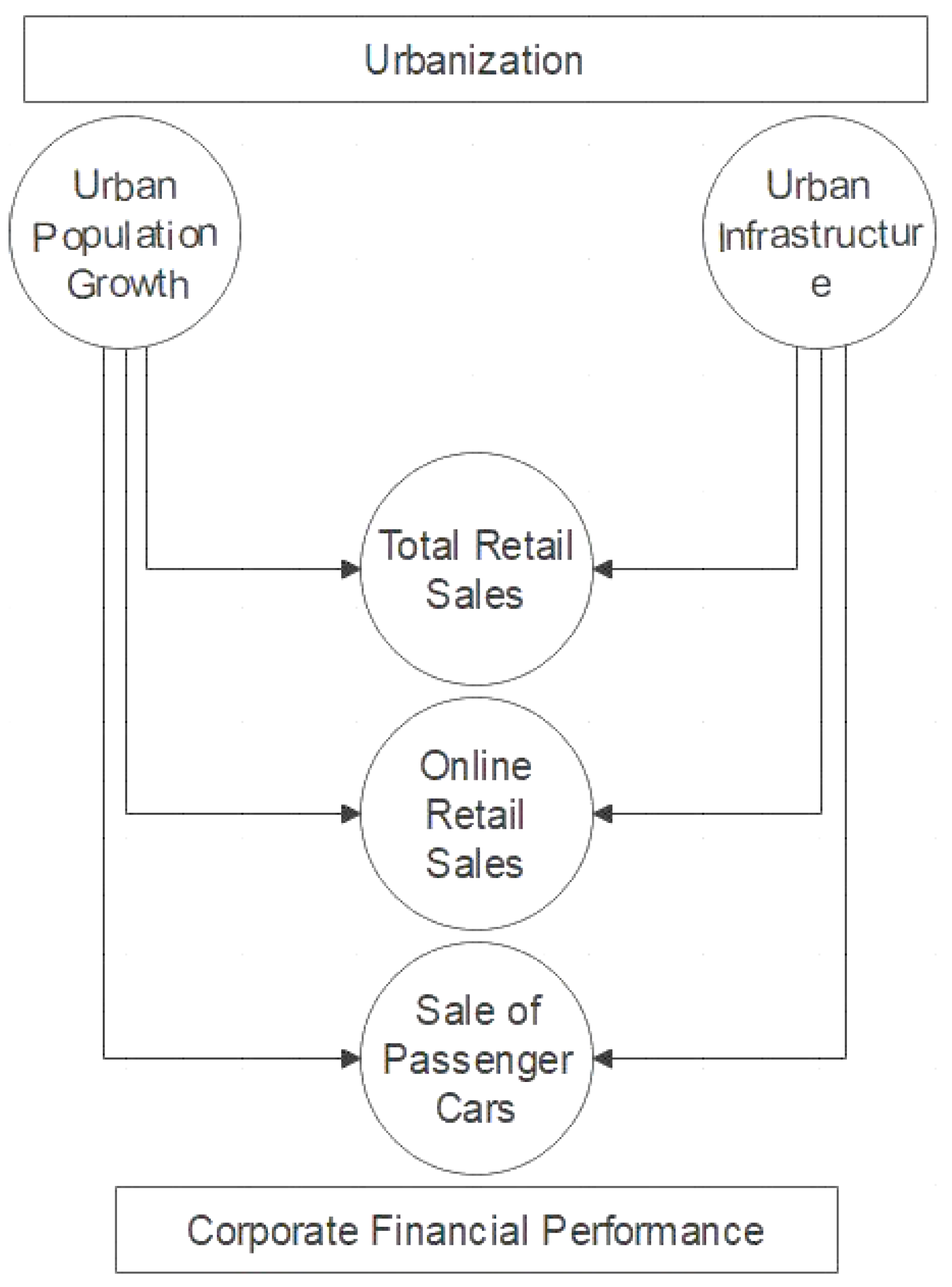

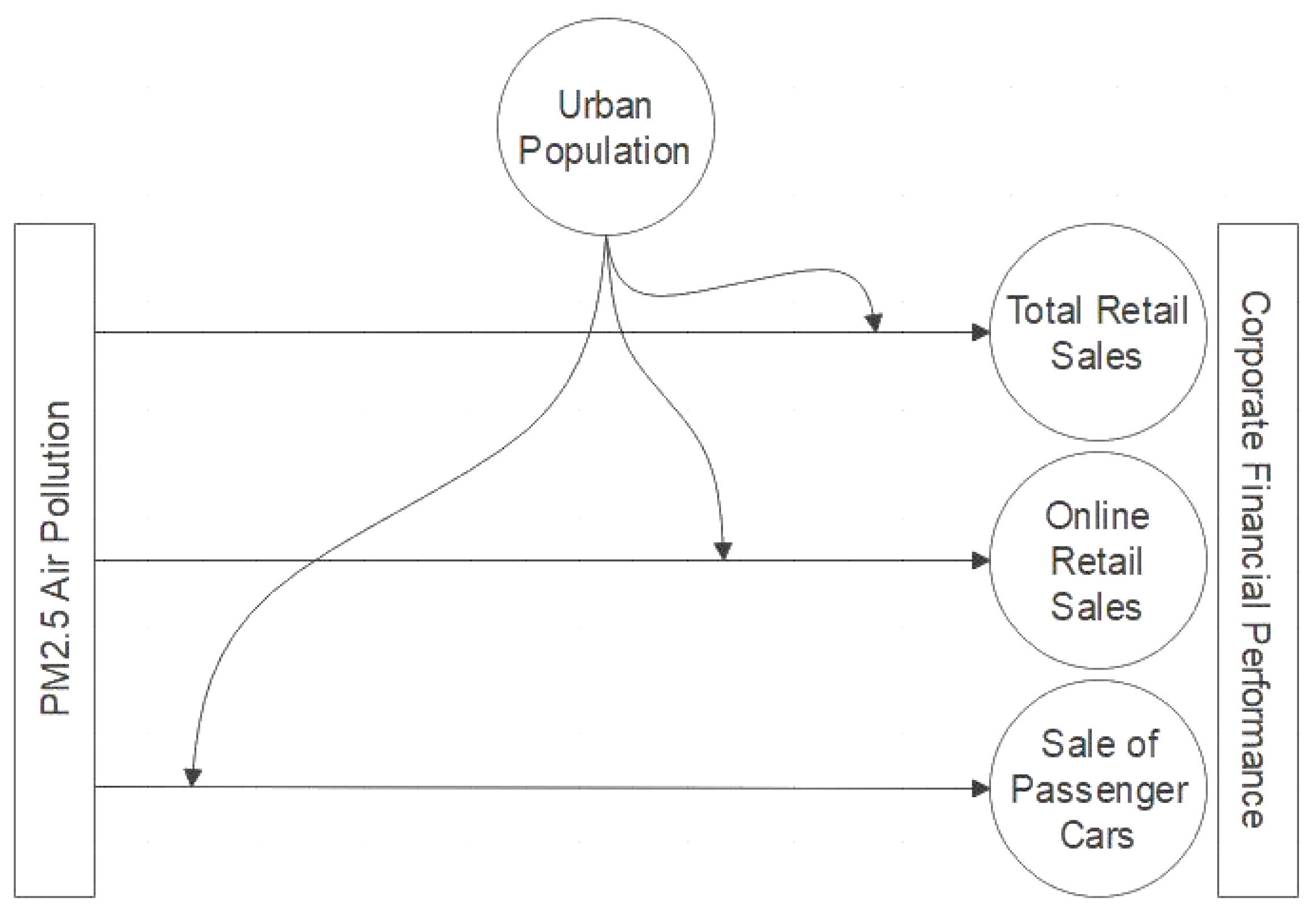

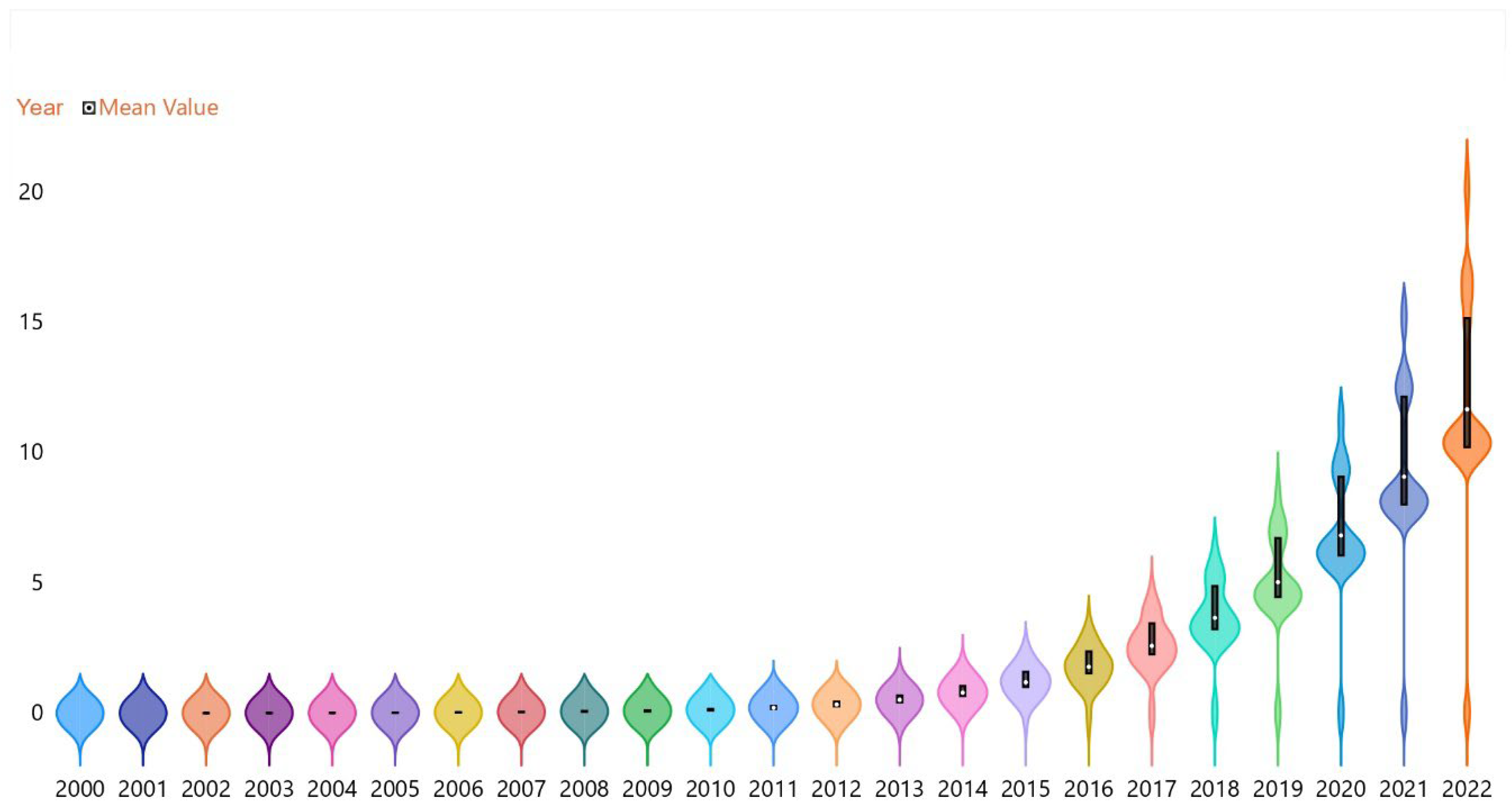
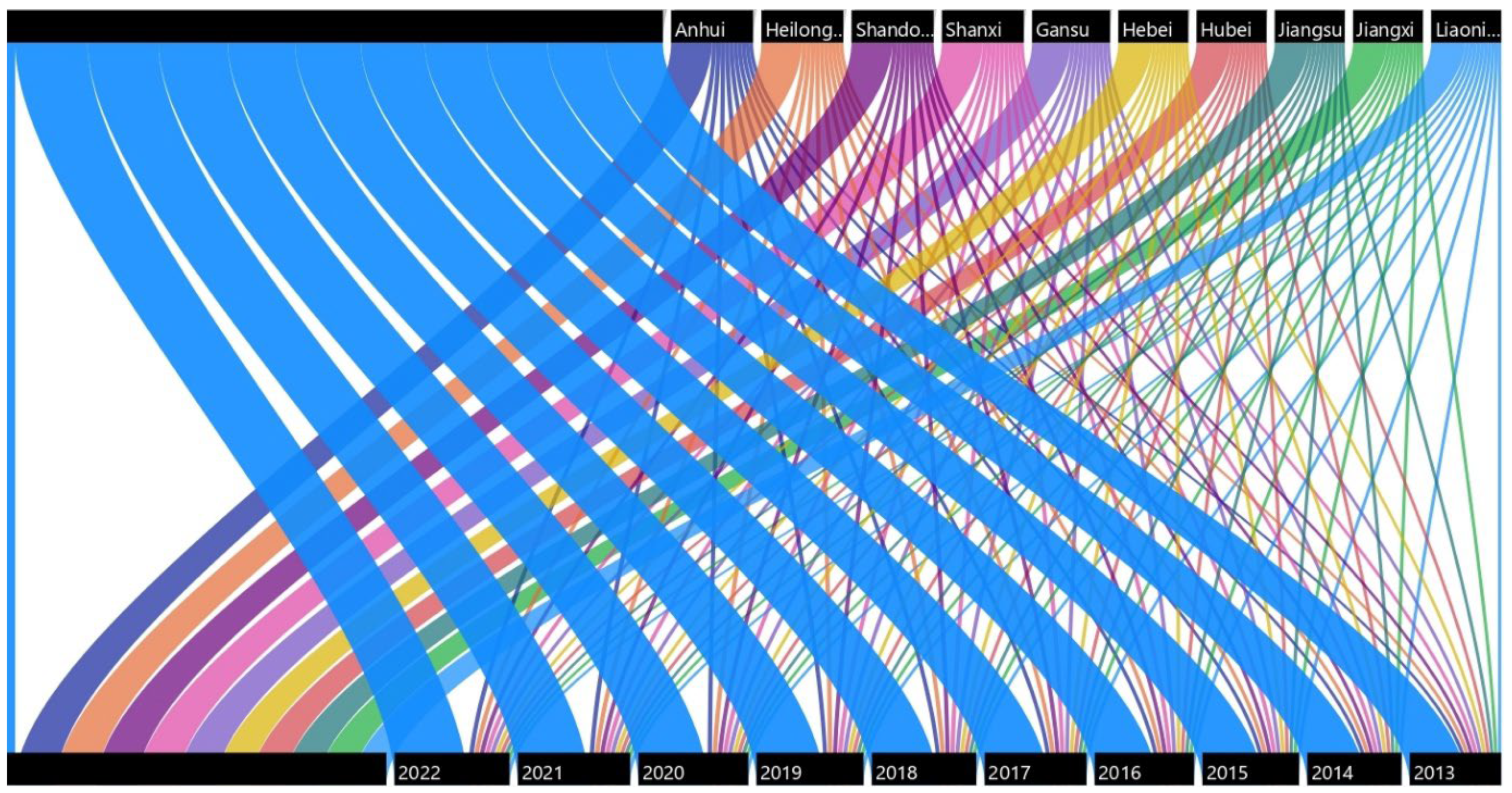

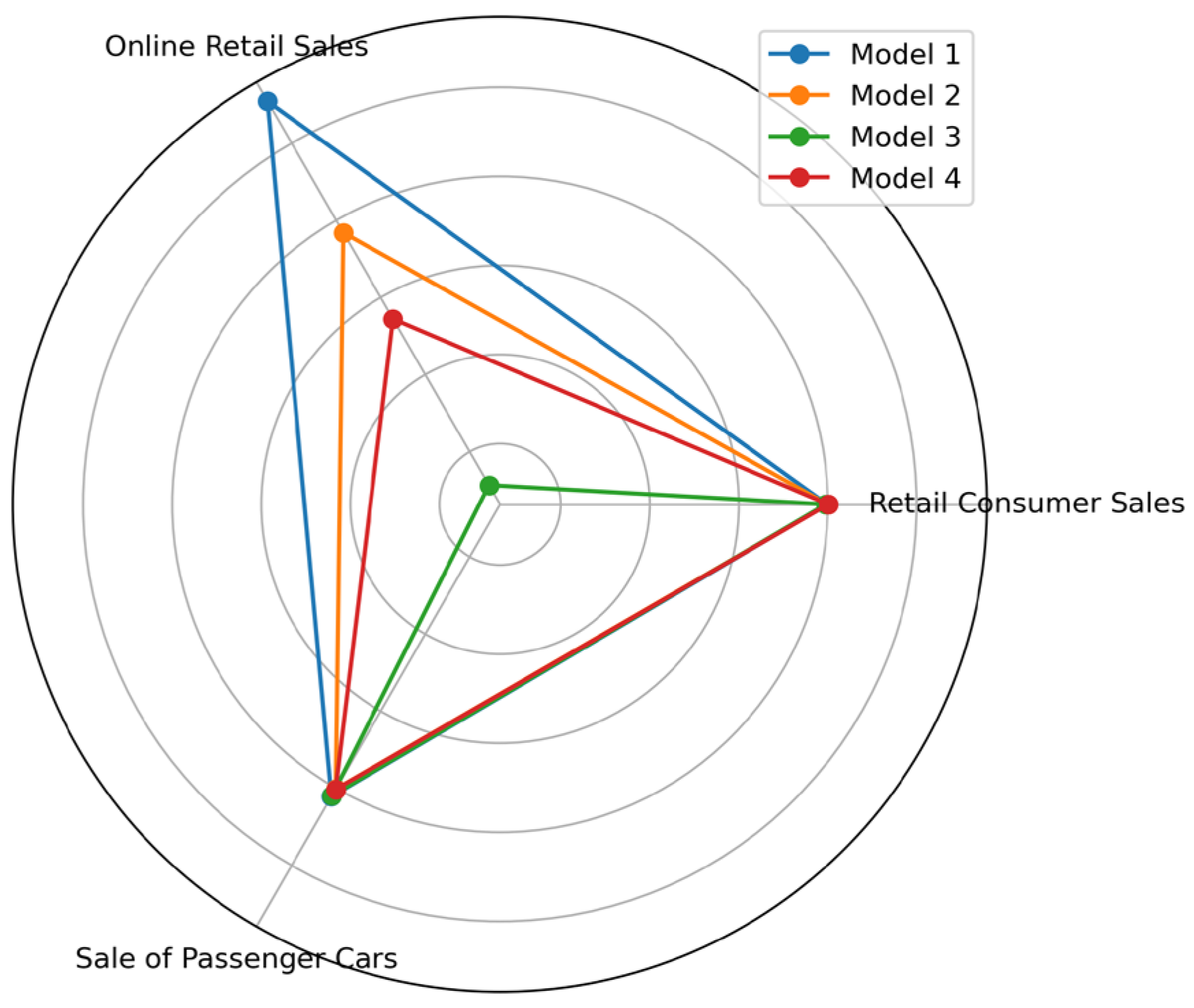

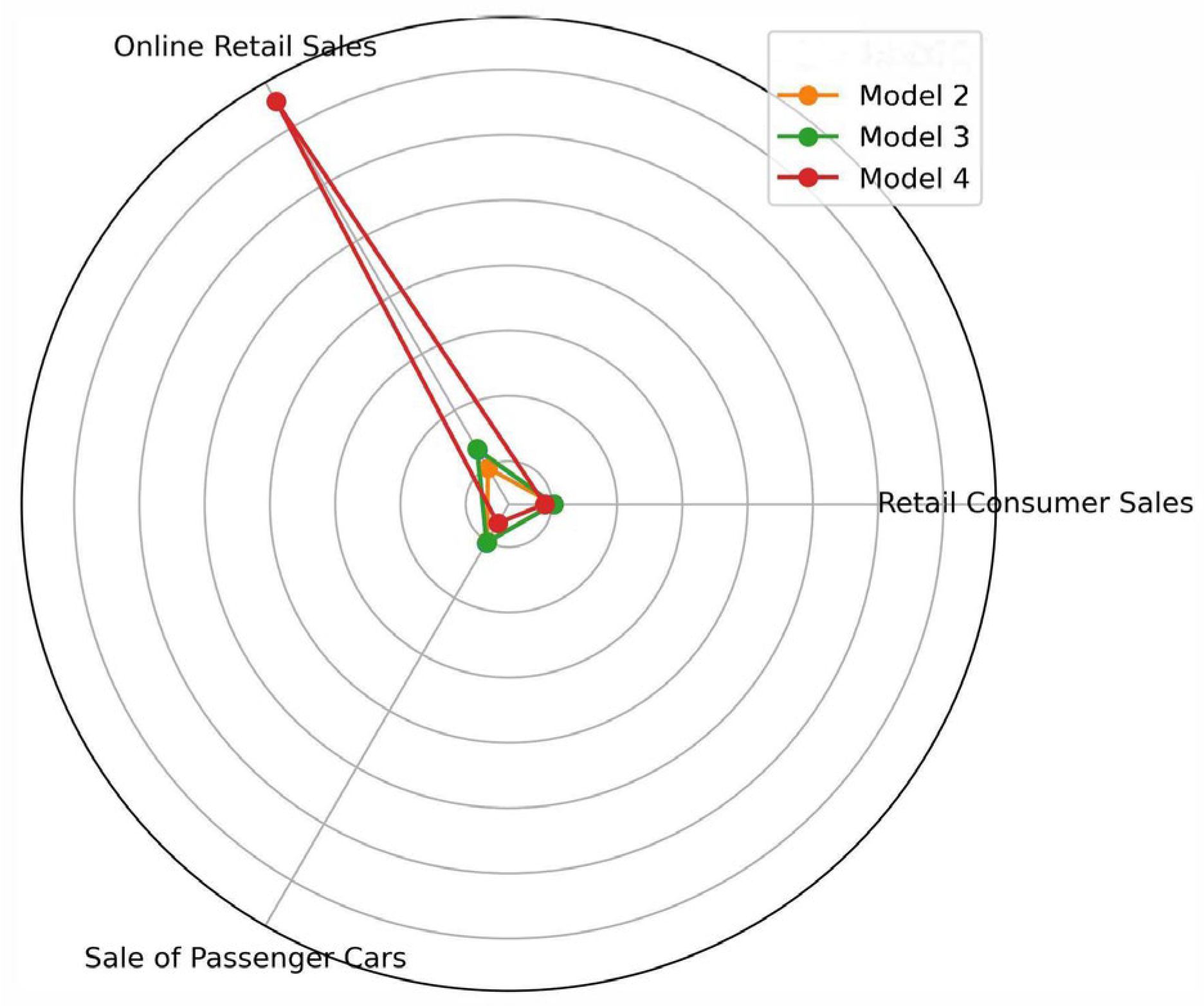
| Variable Name | Nature of Data | Data Source | Collection Method |
|---|---|---|---|
| Total Retail Sales of Consumer Goods (Billion Yuans) | Secondary | Bloomberg | Downloaded from Website |
| Online Retail Sales by Region (Billion Yuans) | Secondary | Bloomberg | Downloaded from Website |
| Sales of Passenger Cars (000) | Secondary | Bloomberg | Downloaded from Website |
| Urban Population (Millions) | Secondary | World Bank | Downloaded from Website |
| Urban Population Growth (%) | Secondary | World Bank | Downloaded from Website |
| PM2.5 Air Pollution (μg/m3) | Secondary | World Bank | Downloaded from Website |
| Urban Infrastructure | Secondary | World Bank | Downloaded from Website |
| Population Density in Urban Areas (Per Square Km) | Secondary | World Bank | Downloaded from Website |
| Urban Land Area (Square Km) | Secondary | World Bank | Downloaded from Website |
| Population Living in Slums (Thousands) | Secondary | World Bank | Downloaded from Website |
| Variable | Obs. | Mean | Std. Dev. | Min. | Max. |
|---|---|---|---|---|---|
| Total Retail Sales of Consumer Goods (Billion Yuans) | 690 | 1.851 | 0.612 | −0.045 | 3.228 |
| Online Retail Sales by Region (Billion Yuans) | 690 | 1.913 | 3.461 | 0.001 | 20.571 |
| Sales of Passenger Cars (000) | 690 | 3.983 | 0.699 | 1.875 | 5.732 |
| Urban Population (Millions) | 690 | 28.714 | 20.104 | 0.88 | 103.640 |
| Urban Population Growth (%) | 690 | 2.301 | 0.669 | 1.000 | 5.447 |
| PM2.5 Air Pollution (μg/m3) | 690 | 165.333 | 39.312 | 70.000 | 260.000 |
| Urban Infrastructure | 690 | 99.957 | 0.170 | 98.300 | 100.000 |
| Population Density in Urban Areas (Per Square Km) | 690 | 2.689 | 0.489 | 1.230 | 3.766 |
| Urban Land Area (Square Km) | 690 | 4.059 | 0.480 | 2.767 | 4.804 |
| Population Living in Slums (Thousands) | 690 | 10.291 | 17.557 | 0.000 | 120.000 |
| Variable | 1 | 2 | 3 | 4 | 5 | 6 | 7 | 8 | 9 | 10 |
|---|---|---|---|---|---|---|---|---|---|---|
| (1) Total Retail Sales of Consumer Goods | 1.000 | |||||||||
| (2) Online Retail Sales by Region | 0.313 *** | 1.000 | ||||||||
| (3) Sales of Passenger | 0.776 *** | 0.247 *** | 1.000 | |||||||
| (4) Urban Population | 0.644 *** | 0.238 *** | 0.527 *** | 1.000 | ||||||
| (5) Urban Population Growth | −0.451 *** | −0.220 *** | −0.398 *** | −0.525 *** | 1.000 | |||||
| (6) PM2.5 Air Pollution | 0.416 *** | 0.647 *** | 0.318 *** | 0.366 *** | −0.339 *** | 1.000 | ||||
| (7) Urban Infrastructure | 0.341 *** | 0.109 *** | 0.367 *** | 0.216 *** | −0.158 *** | 0.236 *** | 1.000 | |||
| (8) Population Density in Urban Areas | 0.720 *** | 0.081 ** | 0.703 *** | 0.414 *** | −0.362 *** | 0.041 | 0.416 *** | 1.000 | ||
| (9) Urban Land Area | 0.150 *** | 0.139 *** | −0.079 ** | 0.588 *** | −0.326 *** | 0.317 *** | 0.011 | −0.143 *** | 1.000 | |
| (10) Population Living in Slums | 0.142 *** | −0.174 *** | 0.043 *** | 0.196 *** | 0.060 | −0.220 *** | 0.077 ** | 0.115 *** | 0.265 *** | 1.000 |
| Without Any Effect | With the Time Effect | With the Region Effect | With the Time and Region Effects | |
|---|---|---|---|---|
| Urban Population Growth | 0.026 *** (0.006) | 0.033 *** (0.008) | 0.028 *** (0.005) | 0.03 *** (0.008) |
| Urban Population | 0.018 *** (0.001) | 0.007 *** (0.0009) | 0.019 *** (0.0009) | 0.006 *** (0.001) |
| Population Density | 1.779 *** (0.088) | 0.561 *** (0.096) | 1.545 *** (0.134) | 0.397 *** (0.133) |
| Urban Land Area | 1.197 *** (0.088) | −0.064 *** (0.096) | 1.588 *** (0.131) | −0.274 *** (0.161) |
| Population Living in Slums | 0.001 *** (0.0003) | 0.001 *** (0.0002) | 0.002 *** (0.0003) | 0.001 *** (0.0003) |
| R2 | 0.563 | 0.710 | 0.670 | 0.713 |
| Wald Test | 8089.36 *** | 15,573.68 *** | 69,511.90 *** | 101,080.73 *** |
| No. of Groups | 23 | 23 | 23 | 23 |
| No. of Observations | 690 | 690 | 690 | 690 |
| Without Any Effect | With the Time Effect | With the Region Effect | With the Time and Region Effects | |
|---|---|---|---|---|
| Urban Population Growth | −0.593 (0.25) | 0.254 (0.176) | −0.803 *** (0.212) | 0.189 (0.192) |
| Urban Population | 0.054 *** (0.013) | 0.049 *** (0.009) | 0.339 *** (0.037) | 0.217 *** (0.025) |
| Population Density | 0.125 (0.467) | −0.659 * (0.360) | 13.918 *** (5.171) | 21.973 *** (2.940) |
| Urban Land Area | 0.398 (0.535) | −0.789 ** (0.401) | 6.032 (5.042) | 3.064 (3.568) |
| Population Living in Slums | −0.06 *** (0.009) | 0.001 (0.005) | 0.032 ** (0.013) | 0.012 ** (0.006) |
| R2 | 0.113 | 0.233 | 0.569 | 0.615 |
| Wald Test | 118.84 *** | 434.55 *** | 865.94 *** | 647.70 *** |
| No. of Groups | 23 | 23 | 23 | 23 |
| No. of Observations | 690 | 690 | 690 | 690 |
| Without Any Effect | With the Time Effect | With the Region Effect | With the Time and Region Effects | |
|---|---|---|---|---|
| Urban Population Growth | 0.091 *** (0.007) | −0.022 *** (0.004) | 0.096 *** (0.006) | −0.022 *** (0.004) |
| Urban Population | 0.01 ** (0.001) | 0.002 *** (0.0005) | 0.011 *** (0.001) | 0.002 *** (0.0006) |
| Population Density | 2.429 *** (0.108) | 0.72 *** (0.065) | 2.2 *** (0.164) | 0.674 *** (0.072) |
| Urban Land Area | 1.563 *** (0.107) | −0.021 (0.074) | 2.054 *** (0.16) | 0.006 (0.088) |
| Population Living in Slums | −0.001 *** (0.0004) | 0.005 *** (0.0002) | 0.005 (0.0004) | 0.005 *** (0.0001) |
| R2 | 0.363 | 0.413 | 0.529 | 0.638 |
| Wald Test | 622.10 *** | 724.50 *** | 642.49 *** | 4532.52 *** |
| No. of Groups | 23 | 23 | 23 | 23 |
| No. of Observations | 690 | 690 | 690 | 690 |
| Without Any Effect | With the Time Effect | With the Region Effect | With the Time and Region Effects | |
|---|---|---|---|---|
| Urban Infrastructure | −0.008 (0.021) | −0.003 (0.016) | −0.021 (0.021) | 0.006 (0.017) |
| Urban Population | 0.018 *** (0.001) | 0.008 *** (0.0009) | 0.019 *** (0.001) | 0.006 *** (0.001) |
| Population Density | 1.769 *** (0.097) | 0.511 *** (0.099) | 1.619 *** (0.162) | 0.292 * (0.156) |
| Urban Land Area | 1.146 *** (0.088) | −0.139 (0.094) | 1.479 *** (0.139) | −0.397 ** (0.159) |
| Population Living in Slums | 0.001 *** (0.0003) | 0.001 *** (0.0002) | 0.002 *** (0.0003) | 0.001 *** (0.0002) |
| R2 | 0.570 | 0.617 | 0.653 | 0.712 |
| Wald Test | 778.04 *** | 1520.60 *** | 6688.63 *** | 9916.76 *** |
| No. of Groups | 23 | 23 | 23 | 23 |
| No. of Observations | 690 | 690 | 690 | 690 |
| Without Any Effect | With the Time Effect | With the Region Effect | With the Time and Region Effects | |
|---|---|---|---|---|
| Urban Infrastructure | 1.542 * (0.822) | −0.16 (0.349) | −3.433 *** (0.791) | −1.279 *** (0.388) |
| Urban Population | 0.06 *** (0.013) | 0.049 ** (0.009) | 0.25 *** (0.041) | 0.198 *** (0.026) |
| Population Density | 0.118 (0.478) | −0.775 ** (0.358) | 28.36 *** (6.093) | 27.423 *** (3.394) |
| Urban Land Area | 0.547 (0.531) | −0.932 (0.393) | 1.142 (5.239) | 1.06 (3.466) |
| Population Living in Slums | −0.065 ** (0.009) | 0.003 (0.005) | 0.02 (0.013) | 0.011 * (0.006) |
| R2 | 0.114 | 0.211 | 0.572 | 0.626 |
| Wald Test | 116.81 *** | 4822.81 *** | 876.29 *** | 6151.72 |
| No. of Groups | 23 | 23 | 23 | 23 |
| No. of Observations | 690 | 690 | 690 | 690 |
| Without Any Effect | With the Time Effect | With the Region Effect | With the Time and Region Effects | |
|---|---|---|---|---|
| Urban Infrastructure | 0.107 *** (0.029) | 0.010 (0.009) | 0.095 *** (0.028) | 0.014 (0.009) |
| Urban Population | 0.013 *** (0.001) | 0.002 *** (0.0006) | 0.014 *** (0.001) | 0.002 *** (0.006) |
| Population Density | 2.14 *** (0.124) | 0.728 *** (0.075) | 1.767 *** (0.220) | 0.662 *** (0.086) |
| Urban Land Area | 1.362 *** (0.112) | 0.062 (0.074) | 2.016 *** (0.189) | 0.108 (0.087) |
| Population Living in Slums | −0.001 ** (0.0004) | −0.006 *** (0.0001) | 0.002 (0.0004) | −0.006 *** (0.0001) |
| R2 | 0.3752 | 0.6063 | 0.626 | 0.698 |
| Wald Test | 5334.18 *** | 68,294.77 *** | 4699.98 *** | 43,062.72 *** |
| No. of Groups | 23 | 23 | 23 | 23 |
| No. of Observations | 690 | 690 | 690 | 690 |
| Without Any Effect | With the Time Effect | With the Region Effect | With the Time and Region Effects | |
|---|---|---|---|---|
| PM2.5 Pollution | 0.005 *** (0.0002) | 0.005 * (0.003) | 0.005 *** (0.0004) | −0.018 * (0.013) |
| Urban Population | 0.008 *** (0.0009) | 0.007 *** (0.0009) | 0.007 *** (0.001) | 0.006 *** (0.001) |
| Population Density | 0.642 *** (0.091) | 0.517 *** (0.091) | 0.549 *** (0.138) | 0.323 ** (0.132) |
| Urban Land Area | −0.102 (0.096) | −0.194 ** (0.100) | −0.181 (0.166) | −0.404 ** (0.158) |
| Population Living in Slums | 0.001 *** (0.0002) | 0.001 *** (0.0002) | 0.001 *** (0.0003) | 0.001 *** (0.0002) |
| R2 | 0.733 | 0.719 | 0.692 | 0.742 |
| Wald Test | 1358.04 *** | 1525.04 *** | 8783.45 *** | 9929.11 *** |
| No. of Groups | 23 | 23 | 23 | 23 |
| No. of Observations | 690 | 690 | 690 | 690 |
| Without Any Effect | With Time Effect | With Region Effect | With Time and Region Effect | |
|---|---|---|---|---|
| PM2.5 Pollution | 0.064 *** (0.003) | 0.003 (0.007) | 0.097 ** (0.017) | 1.379 *** (0.291) |
| Urban Population | 0.011 (0.01) | 0.047 *** (0.009) | 0.119 ** (0.052) | 0.217 *** (0.025) |
| Population Density | 0.095 (0.357) | −0.775 ** (0.345) | −2.127 (5.885) | 21.522 *** (2.904) |
| Urban Land Area | −0.916 ** (0.420) | −0.961 ** (0.392) | −20.479 *** (7.088) | 2.264 (3.474) |
| Population Living in Slums | −0.00 (0.007) | 0.003 (0.005) | 0.011 (0.013) | 0.013 ** (0.006) |
| R2 | 0.426 | 0.492 | 0.580 | 0.613 |
| Wald Test | 617.46 *** | 4813.67 *** | 904.90 *** | 6047.11 *** |
| No. of Groups | 23 | 23 | 23 | 23 |
| No. of Observations | 690 | 690 | 690 | 690 |
| Without Any Effect | With the Time Effect | With the Region Effect | With the Time and Region Effects | |
|---|---|---|---|---|
| PM2.5 Pollution | 0.005 *** (0.0003) | 0.003 (0.003) | 0.002 *** (0.0006) | −0.068 *** (0.007) |
| Urban Population | 0.001 (0.001) | 0.002 *** (0.0006) | 0.006 *** (0.001) | 0.002 *** (0.0006) |
| Population Density | 1.311 ** (0.127) | 0.769 *** (0.066) | 1.74 *** (0.214) | 0.728 *** (0.073) |
| Urban Land Area | 0.263 ** (0.132) | 0.056 (0.076) | 1.104 *** (0.258) | 0.095 (0.087) |
| Population Living in Slums | −0.001 ** (0.0004) | −0.006 *** (0.0001) | −0.004 (0.0004) | −0.006 *** (0.0001) |
| R2 | 0.546 | 0.619 | 0.676 | 0.712 |
| Wald Test | 677.65 *** | 6819.19 *** | 4730.54 *** | 4298.84 *** |
| No. of Groups | 23 | 23 | 23 | 23 |
| No. of Observations | 690 | 690 | 690 | 690 |
| Without Any Effect | With the Time Effect | With the Region Effect | With the Time and Region Effects | |
|---|---|---|---|---|
| PM2.5 Pollution | 0.005 *** (0.0002) | 0.005 * (0.003) | 0.005 *** (0.001) | −0.022 * (0.013) |
| Population Density | 0.713 *** (0.092) | 0.581 *** (0.092) | 0.599 *** (0.138) | 0.36 *** (0.131) |
| Urban Land Area | −0.012 (0.101) | −0.100 (0.104) | −0.144 (0.167) | −0.298 ** (0.157) |
| Population Living in Slums | 0.001 *** (0.0002) | 0.001 *** (0.0002) | 0.001 *** (0.0003) | 0.001 *** (0.0003) |
| PM2.5 Pollution * Urban Population | 0.001 *** (0.0003) | 0.001 *** (0.0003) | 0.001 *** (0.0002) | 0.001 *** (0.0002) |
| R2 | 0.710 | 0.691 | 0.722 | 0.763 |
| Wald Test | 1358.94 *** | 1549.88 *** | 8817.73 *** | 1012.97 *** |
| No. of Groups | 23 | 23 | 23 | 23 |
| No. of Observations | 690 | 690 | 690 | 690 |
| Without Any Effect | With the Time Effect | With the Region Effect | With the Time and Region Effects | |
|---|---|---|---|---|
| PM2.5 Pollution | 0.059 *** (0.003) | −0.004 (0.007) | 0.064 *** (0.017) | 1.293 *** (0.284) |
| Population Density | −0.268 (0.334) | −0.734 ** (0.305) | −0.185 (5.819) | 22.699 *** (2.861) |
| Urban Land Area | −1.361 *** (0.383) | −0.831 ** (0.341) | −8.591 (7.056) | 4.881 (3.419) |
| Population Living in Slums | 0.0008 (0.007) | 0.006 (0.005) | 0.019 * (0.012) | 0.01 * (0.006) |
| PM2.5 Pollution * Urban Population | 0.001 *** (0.0002) | 0.001 *** (0.0002) | 0.001 *** (0.0003) | 0.001 *** (0.0002) |
| R2 | 0.429 | 0.844 | 0.591 | 0.604 |
| Wald Test | 645.00 *** | 5147.70 *** | 949.42 *** | 6278.86 *** |
| No. of Groups | 23 | 23 | 23 | 23 |
| No. of Observations | 690 | 690 | 690 | 690 |
| Without Any Effect | With the Time Effect | With the Region Effect | With the Time and Region Effects | |
|---|---|---|---|---|
| PM2.5 Pollution | 0.005 *** (0.0004) | 0.001 (0.003) | 0.003 *** (0.0006) | −0.064 *** (0.007) |
| Population Density | 1.307 *** (0.128) | 0.773 *** (0.066) | 1.742 *** (0.216) | 0.731 *** (0.073) |
| Urban Land Area | 0.192 (0.138) | 0.013 (0.078) | 0.703 *** (0.263) | 0.038 (0.087) |
| Population Living in Slums | −0.001 *** (0.0003) | 0.002 *** (0.0003) | −0.001 ** (0.0004) | 0.007 *** (0.0009) |
| PM2.5 Pollution * Urban Population | 0.004 (0.0027) | 0.003 * (0.0017) | 0.002 (0.0031) | 0.002 ** (0.0008) |
| R2 | 0.552 | 0.599 | 0.686 | 0.698 |
| Wald Test | 6771.33 *** | 6758.76 *** | 4649.53 *** | 4259.37 *** |
| No. of Groups | 23 | 23 | 23 | 23 |
| No. of Observations | 690 | 690 | 690 | 690 |
Disclaimer/Publisher’s Note: The statements, opinions and data contained in all publications are solely those of the individual author(s) and contributor(s) and not of MDPI and/or the editor(s). MDPI and/or the editor(s) disclaim responsibility for any injury to people or property resulting from any ideas, methods, instructions or products referred to in the content. |
© 2023 by the authors. Licensee MDPI, Basel, Switzerland. This article is an open access article distributed under the terms and conditions of the Creative Commons Attribution (CC BY) license (https://creativecommons.org/licenses/by/4.0/).
Share and Cite
Mahmood, F.; Al-Shattarat, W.; Hamed, R.; Al-Shattarat, B.; Benameur, K.; Hassanein, A.; Tahat, Y. The Influence of Urbanization and Environmental Factors on the Financial Performance of Retail and Automotive Industries in China. Sustainability 2023, 15, 16138. https://doi.org/10.3390/su152316138
Mahmood F, Al-Shattarat W, Hamed R, Al-Shattarat B, Benameur K, Hassanein A, Tahat Y. The Influence of Urbanization and Environmental Factors on the Financial Performance of Retail and Automotive Industries in China. Sustainability. 2023; 15(23):16138. https://doi.org/10.3390/su152316138
Chicago/Turabian StyleMahmood, Faisal, Wasim Al-Shattarat, Ruba Hamed, Basiem Al-Shattarat, Kameleddine Benameur, Ahmed Hassanein, and Yasean Tahat. 2023. "The Influence of Urbanization and Environmental Factors on the Financial Performance of Retail and Automotive Industries in China" Sustainability 15, no. 23: 16138. https://doi.org/10.3390/su152316138






